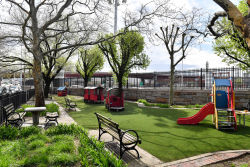Old Hickory Playground
Old Hickory Park
Andrew “Old Hickory” Jackson (1767-1845) was the seventh president of the United States. He earned the nickname, which refers to this strength and stubbornness, from his troops after crushing the British at the Battle of New Orleans during the War of 1812.
The son of Irish immigrants, Andrew Jackson was born in the uncharted Carolinas. Jackson’s father died before his son’s birth, and his mother and brother were both killed during the Revolutionary War. Jackson fought in the Revolution as well, spending time as a prisoner of war before its conclusion. In 1788, he became a prosecuting attorney in the western district of North Carolina, which soon became Tennessee. Soon after, Jackson established his cotton plantation, the Hermitage, where he used slave laborers. He was also married around the same time, but his wife Rachel, had never properly divorced her first husband. Though she and Jackson legally remarried in Nashville in 1791, a sense of scandal always surrounded their relationship.
Jackson’s ascent to high political office was linked to his military achievements. He served in the Tennessee Constitutional Convention, the U.S. House of Representatives and the U.S. Senate. His local constituents elected him Major General of the Tennessee militia in 1802. His valor brought him into the national spotlight during the War of 1812, when his ruthless pursuit of the British led him to a great victory in the Battle of New Orleans. During ongoing conflicts between the U.S. government and native populations, Jackson led violent campaigns against the Creeks in the Mississippi Territory and the Seminoles in the Florida Territory. He became the military governor of Florida in 1821.
Jackson first ran for president in 1824, and despite winning the popular majority he did not obtain enough Electoral College votes to win the four-way race. The House of Representatives chose John Quincy Adams to serve. In 1828, Jackson defeated Adams for the presidency with a large majority, but he also suffered the loss of his wife Rachel, who died on December 22, 1828. Shortly after he took office, Jackson replaced many government officials with his personal and political allies. The adage “To the victor belong the spoils” seemed to fit this Jacksonian philosophy, and this practice of political favors has been called a “spoils system” ever since.
Jackson was popularly recognized as a champion of the “common man” during his eight years as president, and the reputation was not entirely undeserved. Just before the election of 1832, Jackson vetoed the re-chartering of the Bank of the United States because it left a small number of capitalists too much control over public funds. Although the spoils system smacks of corruption, it also meant that ordinary citizens ascended into posts that career politicians might otherwise have monopolized.
On the other hand, Jackson’s opponents had justification for the epithet “King Andrew I.” During the South Carolina tariff (i.e. tax) conflict, he used military force for tariff collection. He forced the relocation of Native Americans to the west of the Mississippi River, a policy responsible for the “trail of tears” on which many died. A slaveowner himself, he condemned abolitionists in the name of preserving tranquility. Jackson may have had an admirably egalitarian vision for American democracy; but it was tainted by an inclination towards violent enforcement and racial prejudice against Native Americans and African-Americans. In 1836, he retired to the Hermitage, where he died on June 8, 1845.
Old Hickory Park is bounded by Jackson Avenue, 51st Avenue, and the Queens-Midtown Tunnel Toll Plaza. Jackson Avenue, like the Jackson Heights neighborhood, bears the name John C. Jackson. He was the president of the Hunter’s Point, Newtown, and Flushing Turnpike Company, which chartered the avenue in 1859. The Queens-Midtown Tunnel, designed by Ole Singstad, runs between 36th Street in Manhattan and Long Island City in Queens. After only four years of construction, the tunnel was completed in 1940. A double tunnel, reaching 6,300 feet in length, the Queens-Midtown Tunnel has computer-controlled ventilation towers that refresh the tunnel air every minute and a half.
Check out your park's Vital Signs
Clean & Safe
Green & Resilient
Empowered & Engaged Users
Share your feedback or learn more about how this park is part of a
Vital Park System




